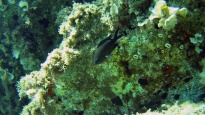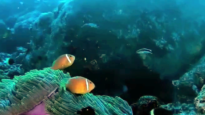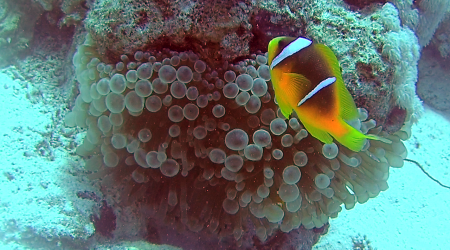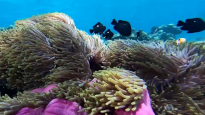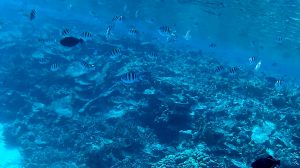Pomacentridi - Pomacentridae
Damselfish - Chromis chromis
Indian Damsel fish - Pomacentrus indicus
Maldive anemonefish - Amphiprion nigripes
Pesce Pagliaccio di Clark - Amphiprion clarkii
Pesci Damigella - Dascyllus trimaculatus
Scissortail sergeant - Abudefduf sexfasciatus
Pomacentrids (Pomacentridae) are a family of over 300 species of marine bony fish of the order Perciformes, known as damsel or damselfish. Pomacentridi Pomacentridae intotheblue.it

Etymology The scientific name derives from the Greek (Poma -operculum and centron -pin) and describes precisely the branchial operculum equipped with a thorn that characterizes this family.
Distribution and habitat They are widespread in all tropical and subtropical seas, up to warm temperate waters. In the Mediterranean they are present with only one species, the damselfish Chromis chromis. Pomacentridi Pomacentridae intotheblue.it

Pomacentrids are almost all marine, with few species that populate the brackish waters. They are strictly coastal. They are among the most typical inhabitants of coral reefs, where they are always numerous as a number of individuals and as a variety of species. Amphiprioninae are known for their association with sea anemones to whose venom they are immune.
Description Pomacentrids generally have a tall and laterally compressed body, sometimes almost discoid in shape. The head is small, the mouth usually small. The teeth are very small, caniniform or incisive-like; teeth are also distributed in the pharynx. The lateral line is incomplete and ends at the height of the end of the dorsal fin, however there are some sensory pores on the caudal peduncle. There is only one nostril on each side of the head.

On the branchial operculum there are often spines and indentations important for determining the genera. Quite large flakes. The dorsal fin is unique and in the front it is composed of robust spiny rays. The anal fin has 2 (rarely 3) spiny rays. The caudal fin is often biloba but sometimes rounded (eg in Amphiprion).
The colors are often bright and variable both according to the places of origin and the life phase.
They are small fish, the maximum length is about 35 cm.

Biology Some species are extremely aggressive and territorial.
Reproduction The eggs are laid on the bottom and are supervised by the male.
Diet The diet is varied and includes herbivorous species such as many Abudefduf, Plectroglyphidodon and Stegastes, omnivores such as Chrysiptera and Pomacentrus and planktophagous such as Chromis, Dascyllus and many others.
Lifecycle Before breeding, the males clear an area of algae and invertebrates to create a nest. They engage in ritualised courtship displays, which may consist of rapid bursts of motion, chasing or nipping females, stationary hovering, or wide extension of their fins. After being attracted to the site, the female lays a string of sticky eggs that attach to the substrate. The male swims behind the female as she lays the eggs, and fertilises them externally. Varying by species, brood sizes range from 50 to 1000 eggs.

The male guards the nest for the two to seven days needed for the eggs to hatch. The transparent larvae are 2 to 4 mm (0.079 to 0.157 in) long. They go through a pelagic stage, which depending on the species, can last as little as a week or more than a month.[9] When they arrive at a suitable environment, the young settle and adopt their juvenile colors.
In captivity, pomacentrids live up to 18 years, but they probably do not live longer than 10 to 12 years in the wild.
https://it.wikipedia.org/wiki/Pomacentridae
https://en.wikipedia.org/wiki/Pomacentridae
Gallery
https://www.intotheblue.it/2021/10/30/pesci-damigella-dascyllus-trimaculatus/
https://www.intotheblue.it/2021/10/17/diving-in-posidonia/
https://www.intotheblue.it/2020/07/18/blue-chromis-chromis/
https://www.intotheblue.it/2018/06/25/pesce-sergente-intotheblue/
https://www.intotheblue.it/2021/03/03/pesce-pagliaccio-coda-gialla/
https://www.intotheblue.it/2019/11/09/amphiprion-clarkii-pesce-pagliaccio-clark-yellowtail-clownfish-intotheblue-it/
https://www.intotheblue.it/2019/12/23/castagnola-nera-chromis-chromis-damselfish-intotheblue-it/
https://www.intotheblue.it/2019/07/09/pesci-blu-chromis-chromis-castagnola-nera-intotheblue-it/
https://www.intotheblue.it/2019/07/02/i-pesci-nuotano-a-testa-in-giu/
https://www.intotheblue.it/2018/06/14/giovani-castagnole-blu-elettrico/
https://www.intotheblue.it/2017/08/28/pesci-blu-elettrico-chromis-chromis/
https://www.intotheblue.it/2017/07/23/castagnole-blu-chromis-chromis/
.

